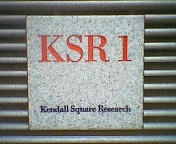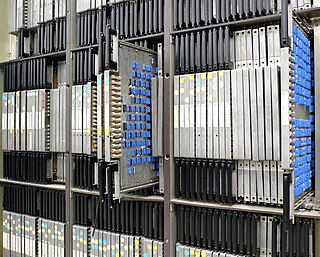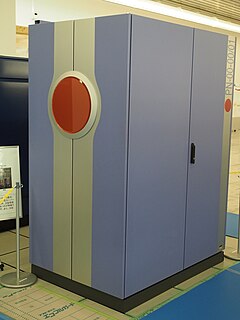
Kendall Square Research (KSR) was a supercomputer company headquartered originally in Kendall Square in Cambridge, Massachusetts in 1986, near Massachusetts Institute of Technology (MIT). It was co-founded by Steven Frank and Henry Burkhardt III, who had formerly helped found Data General and Encore Computer and was one of the original team that designed the PDP-8. KSR produced two models of supercomputer, the KSR1 and KSR2. It went bankrupt in 1994.

A supercomputer is a computer with a high level of performance as compared to a general-purpose computer. The performance of a supercomputer is commonly measured in floating-point operations per second (FLOPS) instead of million instructions per second (MIPS). Since 2017, there are supercomputers which can perform over 1017 FLOPS (a hundred quadrillion FLOPS, 100 petaFLOPS or 100 PFLOPS).

The Cray-1 was a supercomputer designed, manufactured and marketed by Cray Research. Announced in 1975, the first Cray-1 system was installed at Los Alamos National Laboratory in 1976. Eventually, over 100 Cray-1s were sold, making it one of the most successful supercomputers in history. It is perhaps best known for its unique shape, a relatively small C-shaped cabinet with a ring of benches around the outside covering the power supplies and the cooling system.

Control Data Corporation (CDC) was a mainframe and supercomputer firm. CDC was one of the nine major United States computer companies through most of the 1960s; the others were IBM, Burroughs Corporation, DEC, NCR, General Electric, Honeywell, RCA, and UNIVAC. CDC was well-known and highly regarded throughout the industry at the time. For most of the 1960s, Seymour Cray worked at CDC and developed a series of machines that were the fastest computers in the world by far, until Cray left the company to found Cray Research (CRI) in the 1970s. After several years of losses in the early 1980s, in 1988 CDC started to leave the computer manufacturing business and sell the related parts of the company, a process that was completed in 1992 with the creation of Control Data Systems, Inc. The remaining businesses of CDC currently operate as Ceridian.
Convex Computer Corporation was a company that developed, manufactured and marketed vector minisupercomputers and supercomputers for small-to-medium-sized businesses. Their later Exemplar series of parallel computing machines were based on the Hewlett-Packard (HP) PA-RISC microprocessors, and in 1995, HP bought the company. Exemplar machines were offered for sale by HP for some time, and Exemplar technology was used in HP's V-Class machines.

The ILLIAC IV was the first massively parallel computer. The system was originally designed to have 256 64-bit floating point units (FPUs) and four central processing units (CPUs) able to process 1 billion operations per second. Due to budget constraints, only a single "quadrant" with 64 FPUs and a single CPU was built. Since the FPUs all had to process the same instruction – ADD, SUB etc. – in modern terminology the design would be considered to be single instruction, multiple data, or SIMD.

The Cray X-MP was a supercomputer designed, built and sold by Cray Research. It was announced in 1982 as the "cleaned up" successor to the 1975 Cray-1, and was the world's fastest computer from 1983 to 1985 with a quad-processor system performance of 800 MFLOPS. The principal designer was Steve Chen.
ETA Systems was a supercomputer company spun off from Control Data Corporation (CDC) in the early 1980s in order to regain a footing in the supercomputer business. They successfully delivered the ETA-10, but lost money continually while doing so. CDC management eventually gave up and folded the company.

The ETA10 is a line of vector supercomputers designed, manufactured, and marketed by ETA Systems, a spin-off division of Control Data Corporation (CDC). The ETA10 was announced in 1986, with the first deliveries made in early 1987. The system was an evolution of the CDC Cyber 205, which can trace its origins back to the CDC STAR-100.
Alliant Computer Systems was a computer company that designed and manufactured parallel computing systems. Together with Pyramid Technology and Sequent Computer Systems, Alliant's machines pioneered the symmetric multiprocessing market. One of the more successful companies in the group, over 650 Alliant systems were produced over their lifetime. The company was hit by a series of financial problems and went bankrupt in 1992.
Pyramid Technology Corporation was a computer company that produced a number of RISC-based minicomputers at the upper end of the performance range. It was based in the San Francisco Bay Area of California

The CDC 7600 was the Seymour Cray-designed successor to the CDC 6600, extending Control Data's dominance of the supercomputer field into the 1970s. The 7600 ran at 36.4 MHz and had a 65 Kword primary memory using magnetic core and variable-size secondary memory. It was generally about ten times as fast as the CDC 6600 and could deliver about 10 MFLOPS on hand-compiled code, with a peak of 36 MFLOPS. In addition, in benchmark tests in early 1970 it was shown to be slightly faster than its IBM rival, the IBM System/360, Model 195. When the system was released in 1967, it sold for around $5 million in base configurations, and considerably more as options and features were added.

The CDC 8600 was the last of Seymour Cray's supercomputer designs while he worked for Control Data Corporation. As the natural successor to the CDC 6600 and CDC 7600, the 8600 was intended to be about 10 times as fast as the 7600, already the fastest computer on the market. The design was essentially four 7600's, packed into a very small chassis so they could run at higher clock speeds.

The CDC STAR-100 is a vector supercomputer that was designed, manufactured, and marketed by Control Data Corporation (CDC). It was one of the first machines to use a vector processor to improve performance on appropriate scientific applications. It was also the first supercomputer to use integrated circuits and the first to be equipped with one million words of computer memory.

ASCI Red was the first computer built under the Accelerated Strategic Computing Initiative (ASCI), the supercomputing initiative of the United States government created to help the maintenance of the United States nuclear arsenal after the 1992 moratorium on nuclear testing.

The Cray-3 was a vector supercomputer, Seymour Cray's designated successor to the Cray-2. The system was one of the first major applications of gallium arsenide (GaAs) semiconductors in computing, using hundreds of custom built ICs packed into a 1 cubic foot (0.028 m3) CPU. The design goal was performance around 16 GFLOPS, about 12 times that of the Cray-2.

The SX-6 is a NEC SX supercomputer built by NEC Corporation that debuted in 2001; the SX-6 was sold under license by Cray Inc. in the U.S. Each SX-6 single-node system contains up to eight vector processors, which share up to 64 GB of computer memory. The SX-6 processor is a single chip implementation containing a vector processor unit and a scalar processor fabricated in a 0.15 μm CMOS process with copper interconnects, whereas the SX-5 was a multi-chip implementation. The Earth Simulator is based on the SX-6 architecture.
The VP2000 was the second series of vector supercomputers from Fujitsu. Announced in December 1988, they replaced Fujitsu's earlier FACOM VP Model E Series. The VP2000 was succeeded in 1995 by the VPP300, a massively parallel supercomputer with up to 256 vector processors.
The Hitachi SR2201 was a distributed memory parallel system that was introduced in March 1996 by Hitachi. Its processor, the 150 MHz HARP-1E based on the PA-RISC 1.1 architecture, solved the cache miss penalty by pseudo vector processing (PVP). In PVP, data was loaded by prefetching to a special register bank, bypassing the cache. Each processor had a peak performance of 300 MFLOPS, giving the SR2201 a peak performance of 600 GFLOPS. Up to 2048 RISC processors could be connected via a high-speed three-dimensional crossbar network, which was able to transfer data at 300 MB/s over each link.
Adapteva is a fabless semiconductor company focusing on low power many core microprocessor design. The company was the second company to announce a design with 1,000 specialized processing cores on a single integrated circuit.












